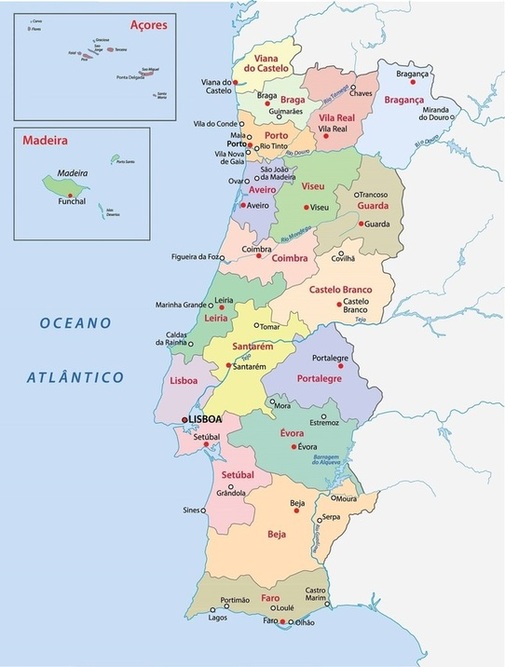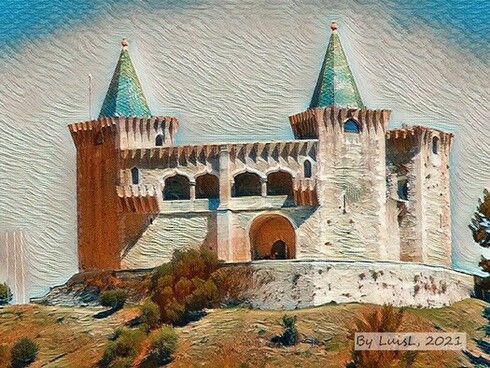
Location - District: Leiria; Municipality: Porto de Mós
Status: Classified as National Monument since 1910
Time of existence of the Castle

The initial occupation of the castle site
Little is known about the occupation of the hill where the castle currently stands in the period prior to the 12th century, as is the case with the neighbouring Ourém Castle.
Regarding a Muslim occupation of this territory, little is also known, not being archaeologically documented its possible occupation, being only known possible influences left in the toponymy of the county (Alvados, Alcaria, Alqueidão) and neighboring regions (Alcobaça, Aljubarrota, Alpedriz, Almofala).
The Medieval Castle
The castle of Porto de Mós is a unique example of military and residential architecture in Gothic and Renaissance styles.
In an urban setting, it is isolated on a hill at an elevation of 148 metres above sea level, overlooking the town of Porto de Mós and from where one can see the valley of the Lena river and the Candeeiros mountains.
The date on which the castle of Porto de Mós was taken by D. Afonso Henriques is still unknown today. It has been suggested, however, that there was an Islamic watchtower, which was conquered by the first king of the Kingdom of Portugal in 1148 (after the conquests of Lisbon, Palmela and Santarém), but material remains of this reality have been slow to appear.
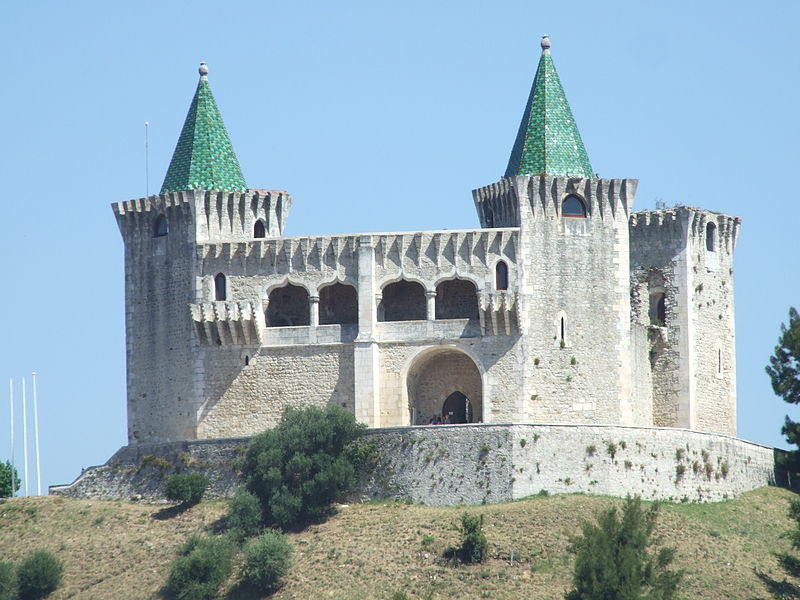
Tradition has it that after the conquest of the fortress, the king left the mythical figure of D. Fuas Roupinho in charge, who in the following years continued to fight battles with the Muslim forces that besieged this castle.
There are two documented Almohad raids on Porto de Mós: the first in 1178 and the second in 1180, led by the Emir of Mérida, who took advantage of the absence of Kingdom troops on conquests in the Alentejo. The raid was carried out with the help of the knights of the Order of Avis.
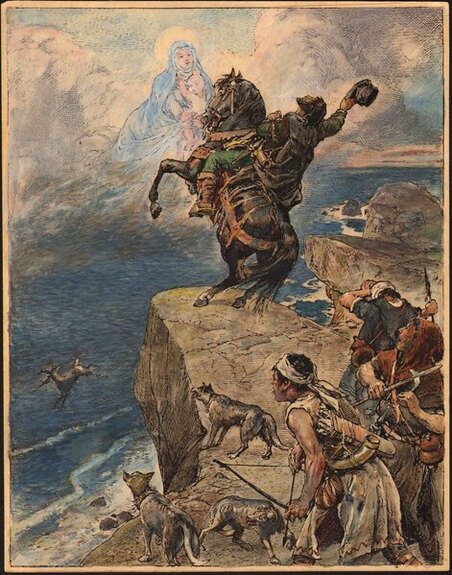
D. Fuas Roupinho - Legend of Nazaré (Watercolour on paper, by Alfredo Roque Gameiro)
D. Fuas Roupinho
This knight also became famous for the legendary episode that occurred at Sítio da Nazaré. According to the legend, D. Fuas Roupinho was hunting and dense fog lifted.
As this one neared the abyss, a powerful force immobilizes the knight and his mount, saving them from more than certain death.
After the death of D. Fuas Roupinho in 1182, the Muslim troops have made another attack on Porto de Mós, destroying the village, which would only be rebuilt and populated around 1200, by order of D. Sancho I.
The monarch D. Sancho I is attributed the first military construction, later enlarged and reinforced during the reign of D. Dinis, during a campaign that surrounded the entire settlement.
During the crisis of 1383-1385, the town and its castle sided with the Master of Avis. The Portuguese forces, under the command of the sovereign, camped here on their way to the battle of Aljubarrota (1385).
August 14th 1385 was approaching. Two days earlier, in the summer of that distant year, the Kingdom's troops commanded by D. João I and D. Nuno Álvares Pereira had rested in the vicinity of Porto de Mós.
They were going to face the numerous Castilian army that was approaching the region. The decisive day arrived and the inevitable confrontation took place, on the fields of Aljubarrota.
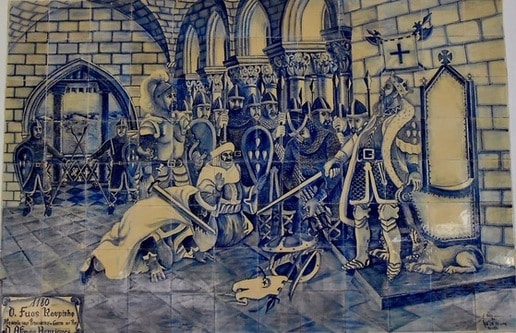
Porto de Mós - Municipal Garden of S. Pedro
Tile panel "D. Fuas Roupinho" (by Victor Santiago, 1985)
In this tile panel, D. Fuas Roupinho, wearing clothes and weapons of the time presents his Muslim prisoners of war to King D. Afonso Henriques.
This battle, where Portugal was defending its independence from Castile, is a milestone in the History of this country and was translated into a unique victory, strategically very well outlined, of the forces of the reign of Portugal.
About D. Nuno Álvares Pereira we can say that is considered the greatest strategist, commander and Portuguese military genius of all time. He commanded forces substantially inferior in number to the enemy and won all the battles he fought.
He is the patron saint of the Portuguese Infantry. His way of commanding was fundamentally characterised by his example and countless military virtues with his men.
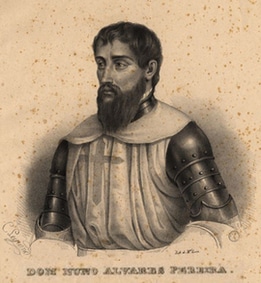
D. Nuno Álvares Pereira, by Charles Legrand (1838-1850), National Library of Portugal
After the victory and as a form of recognition D. João I, makes a letter of donation to the Constable D. Nuno Álvares Pereira, giving him among other towns the county of Ourém and Porto de Mós.
He bequeathed Porto de Mós to his daughter and son-in-law - the first Dukes of Bragança - in his will.
It is at this time (in the second half of the 15th century), when the town came into the possession of his son, D. Afonso (Count of Ourém and 1st Marquis of Valença), that the most important constructive contribution to the history of Porto de Mós occurred.
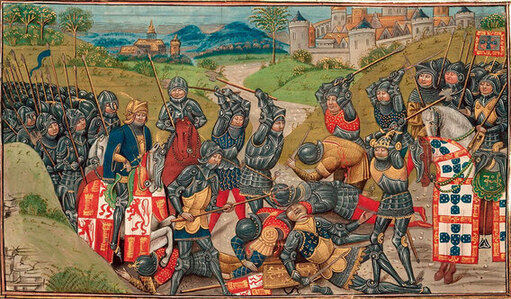
XV century illumination representing the Battle of Aljubarrota
(in Jean de Wavrin, Chronique d'Angleterre, British Museum, London)
It should be noted that D. Afonso was a cultured and well-travelled diplomat and military man, and decided to transform the medieval fortress into a palatial residence.
In Ourém, the count commissioned major works, in a style of Italianism that was unique in Portugal. The majestic palace he built in the castle of Porto de Mós is part of this same movement and is one of the most important chapters in the evolution of 15th century Portuguese art.
XVIII and XIX Centuries
However, the inexorable passage of time and natural disasters severely damaged part of the castle, particularly the ruined north-facing façade.
Around 1735 one of the five towers of the castle collapsed. During the earthquake of November 1, 1755, the castle was severely damaged and only three towers remained standing, but they were badly ruined.
The wall remained open on the north side, and part of the balcony on the south side collapsed. In 1909 a new earthquake destroyed three of the arcades of the balcony, leaving the vaults visible.
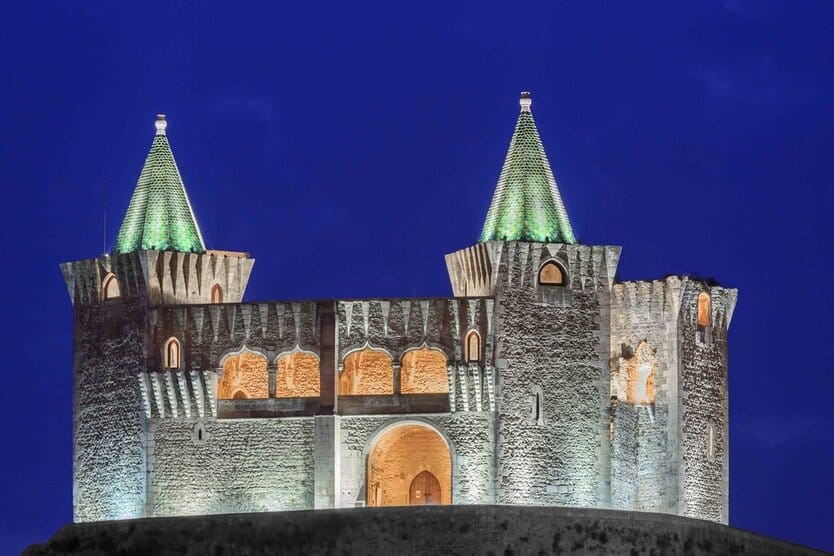
Castle of Porto de Mós by night
XVIII and XIX Centuries
The intervention of the public power took place from 1936 by the Direcção Geral dos Edifícios e Monumentos Nacionais (D.G.E.M.N.), which promoted extensive intervention of cleaning, conservation and restoration that lasted until the end of the 1950s.
Further interventions took place in 1960 (installation of the castle's "festive" lighting), in the first half of the 1970s, in the 1990s (when archaeological excavations took place, 1991-1992), in 2001 and between 2004-2007.
More recently, in 2019, new rehabilitation and accessibility interventions were carried out, aiming to preserve the Castle and make it more inclusive.
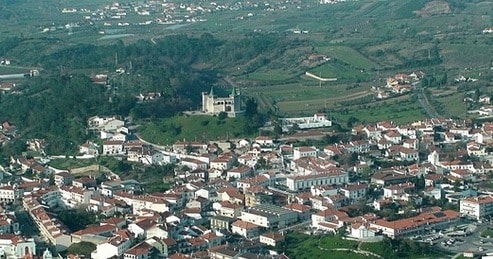
Aerial view of Porto de Mós and its castle
Like it? Then share it!

